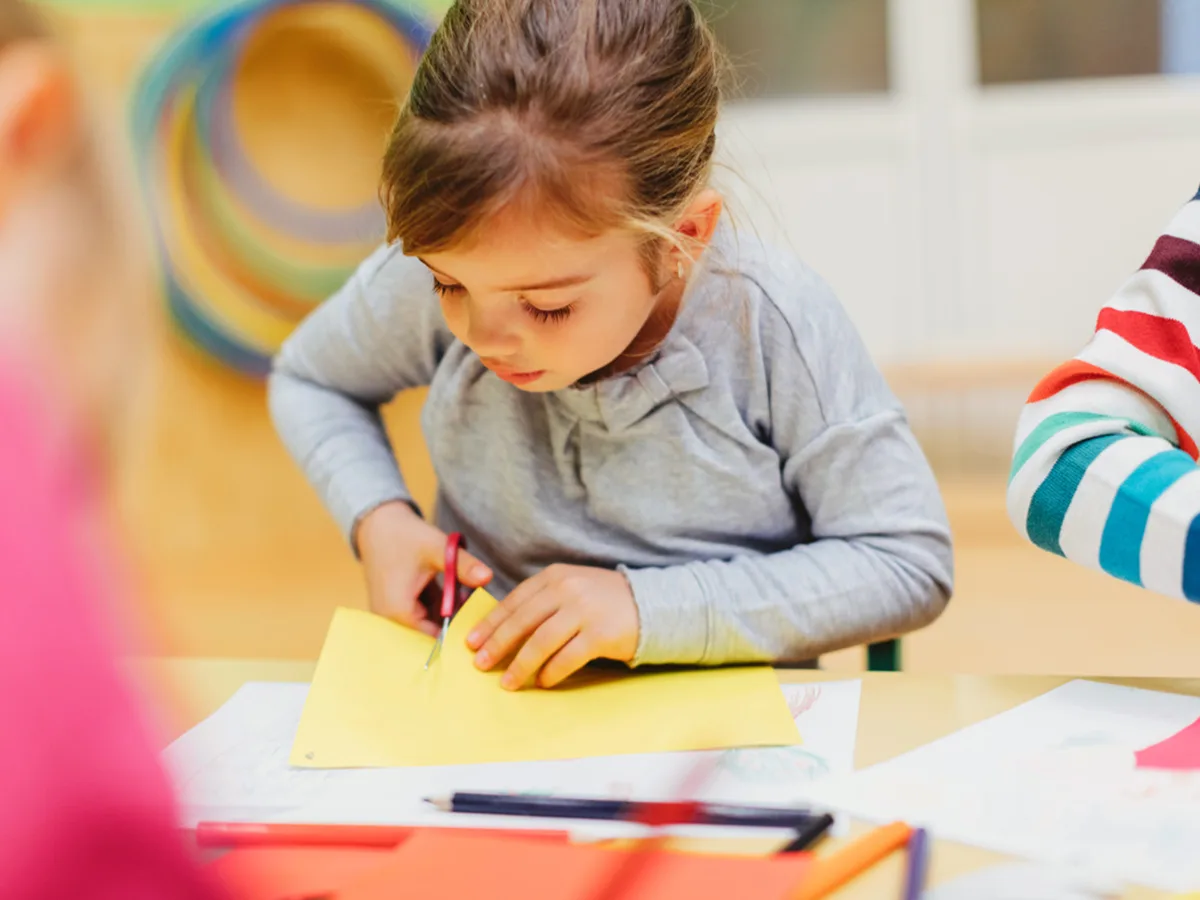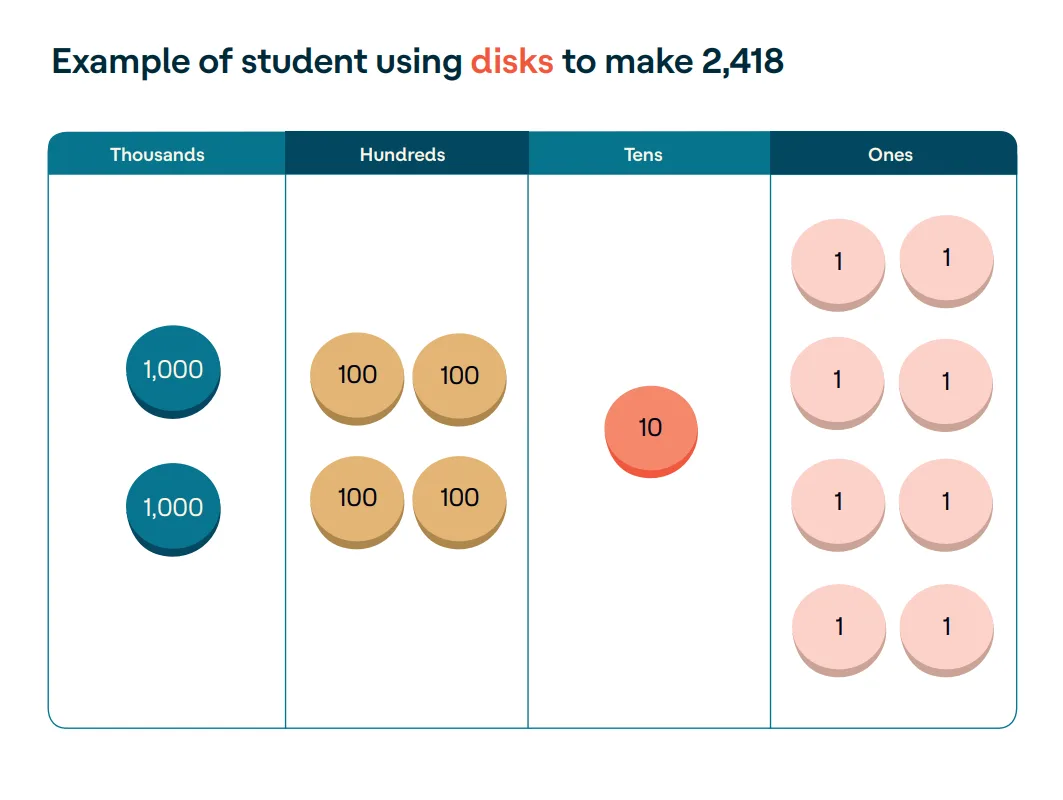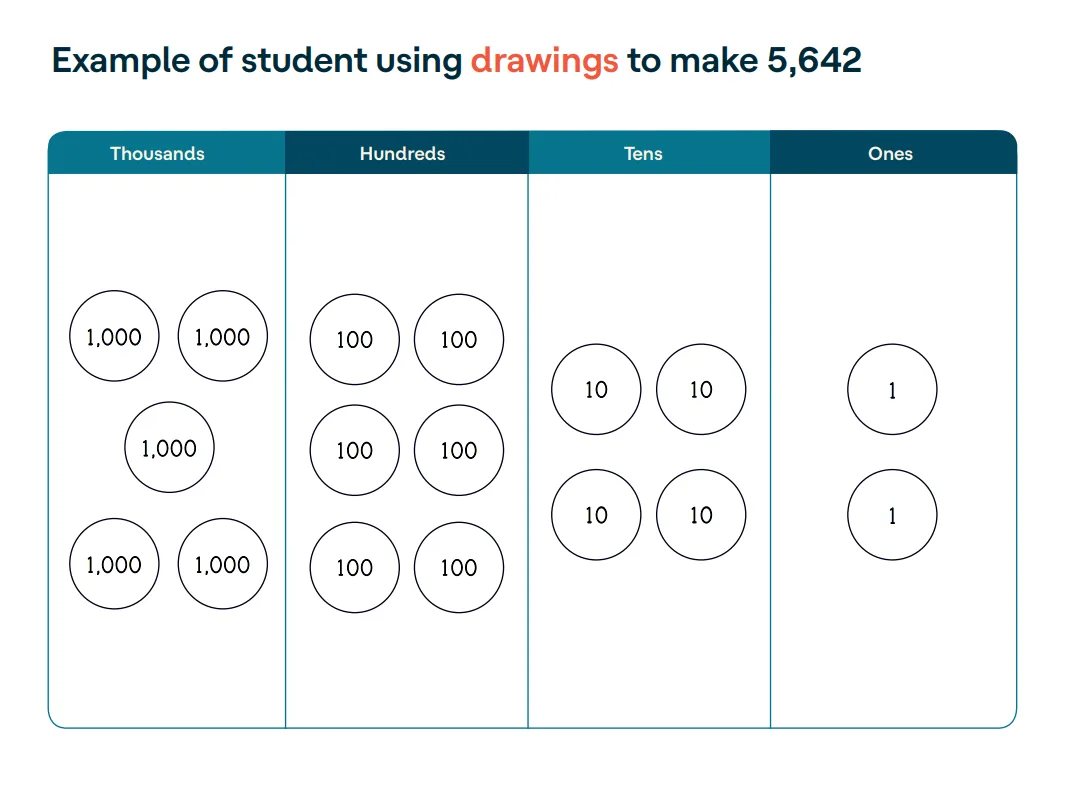Place value disks: An evidence-based math strategy

Place value can be a tricky concept to master. Use this strategy to help students in third, fourth, and fifth grade expand their understanding of place value as they compose (or “make”) four-digit numbers.
In the early elementary grades, students should have learned that the value of a digit depends on its place in a number. They most likely did this by composing two- and three-digit numbers.
With this strategy, students will compose four-digit numbers using manipulatives called place value disks. These place value disks (sometimes called place value chips) are circular objects that each represent 1, 10, 100, or 1,000.
For example, in the number 6,142, the digit 6 is represented by six thousands disks, the digit 1 is represented by one hundreds disk, the digit 4 is represented by four tens disks, and the digit 2 is represented by two ones disks.
Before you get started, make sure your students understand place value with two- and three-digit numbers. (You may want to use straw bundles as a more concrete way of showing place value.) Then, you can move on to this strategy of using place value disks with larger numbers.
Download: Use these printable resources
Place value mat - thousandsPDF - 31.1 KB
Place value disks printablePDF - 43.1 KB
Read: How to use this place value strategy
Objective: Students will compose multi-digit numbers and explain what the digit in each place represents.
Grade levels (with standards):
3 (Common Core 3.NBT.A.1: Use place value understanding to round whole numbers to the nearest 10 or 100)
4 (Common Core 4.NBT.A.1: Recognize that in a multi-digit whole number, a digit in one place represents ten times what it represents in the place to its right)
5 (Common Core 5.NBT.A.1: Recognize that in a multi-digit number, a digit in one place represents 10 times as much as it represents in the place to its right and 1/10 of what it represents in the place to its left)
3–5 (Common Core Math Practice MP2: Reason abstractly and quantitatively; Common Core Math Practice MP5: Use appropriate tools strategically)
Best used for instruction with:
Whole class
Small groups
Individuals
How to prepare:
Gather materials. Give each student a place value mat and a set of place value disks. Have students cut out the disks.
Students who struggle with fine motor skills may find it difficult to cut out or handle paper disks. The disks may also be too small for students with low vision. It’s important for students to be able to use manipulatives in this strategy, so consider these options:
Enlarge the disks when you print them out
Print the disks on card stock
Cut the disks before the lesson
Use bingo chips with the numbers written on them
Create your own set of disks on cardboard for working one-on-one with students
How to teach:
1. Introduce vocabulary. Explicitly review the academic vocabulary needed for the lesson, including place value, ones, tens, hundreds, and thousands. Use the place value mat to point to each of the column headings.
For English language learners (ELLs): Talk about the difference between the terms ten and tens. Explain that ten (or 10) refers to the number that is more than 9 but less than 11. Show ten with a collection of individual objects, like 10 pencils. Then explain that tens refers to how many groups of 10 are used to make a number. For example, the number 60 means there are six tens, or six groups of 10. Ask, “Remember how we have shown six tens in the past?” Show groups of 10 with straw bundles (or other objects) to remind students of previous lessons.
2. Explain place value disks. Explain to students that they’ll be using place value disks to help understand place value. Display each of the disks — 1, 10, 100, and 1,000. Point out the different colors for each type of disk.
Model how to count 10 ones disks and then exchange them for 1 tens disk. Do the same for 10 tens disks and exchange them for 1 hundreds disk. And then again, count 10 hundreds disks and trade them for 1 thousands disk. Students can practice doing the same with their disks. To represent this idea another way, count 10 ones, then write a sentence frame on the board: "____ ones disks make ____ tens disk." Fill in the sentence frame blanks as a class: "10 ones disks make 1 tens disk."
This is a good opportunity to talk about the relationship between each place. For instance, the thousands place is 10 times the hundreds place.
3. Start with the concrete. Use the concrete-representational-abstract (CRA) sequence of instruction to have students compose (or “make”) a number using their place value mat and disks. Model how to put the place value disks on the place value mat to compose a four-digit number. For example, you can make the number 2,418 with 2 thousands disks, 4 hundreds disks, 1 tens disk, and 8 ones disks.
Do a think-aloud as you model how to put the disks on the mat. For instance, you might say “To make two thousand, I know I need two thousands disks, so here’s one thousands disk and here’s another thousands disk” and so on. Then invite students to practice doing the same with several numbers. Give them feedback as they work.

Teaching tip: To connect numbers with real-world uses, you can identify four-digit numbers around your school, like the year the school was built. You can also use numbers that are important to students, like the year they were born.
4. Move to the representational. Once students show an understanding of how to make numbers using the disks, move on to the representational level. Model how to draw circles on the place value mat: Draw a circle in the appropriate column and write the corresponding number (1, 10, 100, or 1,000) in the circle. (If students have trouble drawing circles, they can trace a coin.)
For example, to represent the number 5,642, draw 5 thousands circles, 6 hundreds circles, 4 tens circles, and 2 ones circles. Then, have students draw circles in the appropriate columns on their own place value mats to make a four-digit number.
Provide plenty of opportunities for practice and feedback. Invite students to explain what they placed in each column and say the standard number. Many students will benefit from using sentence frames to share their numbers, including ELLs and students who struggle with expressive language. You can use and display this frame: “My number is ____. It is made up of ____ thousands, ____ hundreds, ____ tens, and ____ ones.”

Teaching tip: To reuse the place value mats throughout the lesson, put the mats inside dry-erase pockets. Have students use dry-erase markers to record their responses. Then they can erase and move on to the next example. You can also put copies of the sentence frames inside the pockets.
5. End with the abstract. After mastering the representational level, move on to the abstract level. On a place value mat, have students compose a number using only written numbers — like 8 thousands, 7 hundreds, 1 tens, and 7 ones make 8,717. They can both write the number and read it aloud.
If students struggle to make the leap to the abstract level, prompt them to go back to using the place value disks and then the drawings. Don’t rush to move on to the abstract until they’ve shown mastery with those scaffolds.

6. Continue to use the disks. Place value disks and the thousands mat can support students as they continue to work with multi-digit numbers. The mat and disks can help students with rounding to the nearest ten, hundred, or thousand. These resources can also help students understand how to operate with multi-digit numbers. For example, you can use the mat and disks to help students with expanded notation when adding and subtracting.
Understand: Why this strategy works
Students who learn and think differently may have trouble making a connection between our base 10 number system and the language we use for numbers. That’s because the language we use for numbers doesn’t directly translate. For example, we write “2,316,” not “2000 300 10 6.”
Composing numbers using place value disks will help students make the connection between the number system and language. The disks show students that a number is made up of the sum of its parts. The disks also help students compare the value of each place, like that the tens place is 10 times the ones place.
Using multiple models, including place value disks, straw bundles, and drawings can help all students understand place value. They also learn from support and feedback as they move from concrete to abstract representations of a number.
When students understand the concept of place value, they’ll have a strong foundation for more advanced math work, including addition with regrouping, multiplication, fractions, and decimals.
Connect: Link school to home
Families may be familiar with place value, but they may have learned about it in a different way when they were in elementary school.
In your class newsletter or at a school event, explain how you’re teaching place value. Share resources that families can use to practice the concept of place value at home, including how to use multisensory techniques for place value and other math concepts. If you teach fourth grade, you can also share information about why math at this grade level can be hard.



